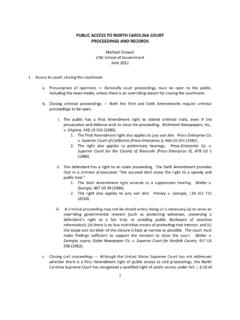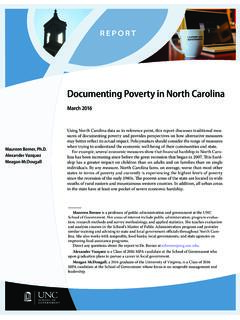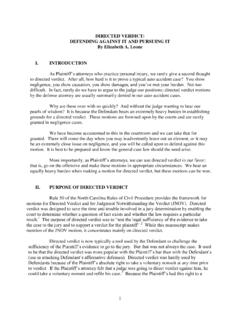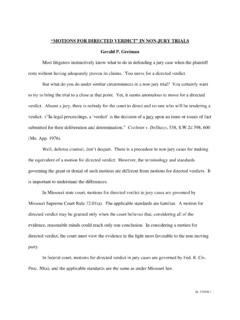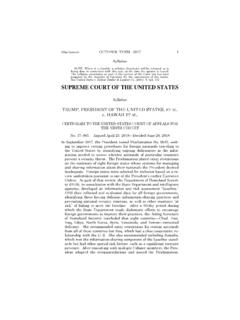Transcription of Civil Dispositive Motions: A Basic Breakdown
1 1 Civil Dispositive Motions: A Basic Breakdown 1) Simplified Timeline: 2) Pre-Trial Motions: Rule 12(b)(6) and Summary Judgment A. Rule 12(b)(6) Motions to Dismiss 1. Challenge the sufficiency of the complaint on its face. Movant asks the court to dismiss the complaint for failure to state a claim upon which relief may be granted. 2. Standard: The court may grant the motion if the allegations in the complaint are insufficient or defective as a matter of law in properly stating a claim for relief. For example: a) The complaint is for fraud, which requires specific pleading, but a required element of fraud is not alleged.
2 * Defendant may move at any time. Plaintiff must wait until 30 days after commencement of action. **Movant must have moved for after close of evidence. Complaint Filed Trial Begins Discovery and Mediation Process Motion for (Rul Motion for Motion for JNOV** Motion for New Trial Jury s Verdict Defendant s Evidence Plaintiff s Evidence 10 days 12(b)(6) Motions Summary Judgment Motions* Entry of Judgment 2 b) The complaint alleges breach of contract, but incorporates by reference (and attaches) a contract that is unenforceable as a matter of law. c) The complaint alleges a claim against a public official in a context in which that official has immunity as a matter of law.
3 3. The court only looks at the complaint (and documents incorporated by reference). a) If the court looks outside the complaint, the motion is effectively converted to a summary judgment and should be treated under the provisions of Rule 56. 4. All allegations of the complaint must be accepted as true. 5. Rule 12(b)(6) motions should be granted carefully and sparingly and are not generally favored. a) If the defect can be repaired with an amendment to the complaint, the court should consider allowing the plaintiff the chance to correct the defect. b) Motions to dismiss under Rule 12(b)(6) are adjudications on the merits, and therefore should be granted with caution.
4 B. Summary Judgment (Rule 56) 1. Summary judgment motions ask the court to examine the record and determine whether any material questions exist for a jury to decide. 2. Standard: Court shall grant a motion for summary judgment if there is no genuine issue of material fact as shown by the pleadings, depositions, answers to interrogatories, and admissions on file, together with the affidavits, if any. a) The record must be viewed in the light most favorable to the party against whom judgment is sought. b) The court may grant summary judgment as to all of the claims or only a portion of them.
5 Rule 56(c). (1) If only a portion of the claims are adjudicated, the court shall specify the remaining material issues in an order, and those issues shall proceed to trial. Rule 56(d). 3 c) The court may grant summary judgment as to liability only and leave damages for the jury, as appropriate. Id. d) The court may also grant summary judgment against the moving party, if appropriate. Rule 56(c). e) Summary judgment is available in declaratory judgment actions. Rule 56(a). 3. The Motion: a) May be filed by a defending party any time. May be filed by a complaining party any time after 30 days from commencement of action.
6 Rule 56(a), (b). b) The motion must be filed at least 10 days prior to hearing. Rule 56(c). (1) Court is not required to conduct a hearing, but it is common to do so upon notice of the moving party. (2) If the non-moving party files affidavits in opposition to the motion, they must be served on the movant (personal delivery, fax, or other actual delivery) at least 2 days prior to hearing. (a) Court may continue the hearing for any reasonable time or take other reasonable action to allow service of affidavits. 56(c), (f). (b) Affidavits must meet essential evidentiary thresholds for admissibility, including competency, personal knowledge, and absence of hearsay.
7 Rule 56(e). 3) At Trial and Post-Trial: directed Verdict, JNOV, and New Trial A. directed Verdict, JNOV (Rule 50) 1. directed Verdict a) After Plaintiff s evidence or after the close of all the evidence, a party may move for a directed verdict in its favor. 4 b) Standard: If the non-moving party s evidence is insufficient as a matter of law to go to a jury, the Court should grant a directed verdict for the moving party. c) Granting motions for plaintiff: A court may grant a directed verdict motion for the party with the burden of proof, although it is not common. Doing so at the close of that party s evidence is even more rare, and should be done only if the defendant cannot put on contrary evidence as a matter of law.
8 2. Judgment Notwithstanding the Verdict (JNOV) (Rule 50(b)) a) If a losing party has moved for directed verdict at the close of all the evidence, and it was not granted, that party may move again for a judgment in its favor if the verdict is for the opponent. b) Timing: The motion must be made within 10 days after entry of judgment. The court may also make the motion on its own. c) Standard: If the directed verdict could properly have been granted for the movant, the court should grant JNOV. (JNOV can also be thought of as a directed verdict after the verdict. ) 3. JNOV Combined with Motion for New Trial (Rule 50(c), 59): a) A losing party may move for a new trial on grounds that the credible evidence was strongly in its These motions are often combined with motions for JNOV, and they have the same 10-day time limit.
9 B) If a judge determines the standard for JNOV is not met, but that the evidence strongly weighed in favor of the losing party, he or she may grant a new trial. (1) See Decision Diagram below. (2) This decision is in the judge s discretion, and the Court of Appeals reviews it only for manifest disregard of the record. 1 Rule 59(a)(7). There are eight other bases for granting a new trial, including: irregularities preventing a fair trial; misconduct of jury or opposing party; accident or surprise; new, previously undiscoverable evidence; jury disregard for court s instructions, excessive or inadequate damages; error of law; and any other reason established in prior case law.
10 Rule 59(a)(1)-(6), (8). 5 c) Conditional Ruling: If the judge grants JNOV, he or she must also make a conditional ruling on the new trial motion. Rule 50(c)(1). (1) New trial conditionally granted: If appellate court reverses JNOV, new trial will proceed unless Court of Appeals rules otherwise. (2) New trial conditionally denied (unusual): Movant may appeal the denial. Case proceeds according to the ruling of the appellate court. B. directed Verdict/JNOV/New Trial Decision Diagram: * This diagram assumes a jury trial. In a non-jury trial, the court, as finder of fact, may grant a Rule 41(b) dismissal for defendant at close of plaintiff s evidence even where the plaintiff has presented evidence that would be sufficient to take to a jury.


